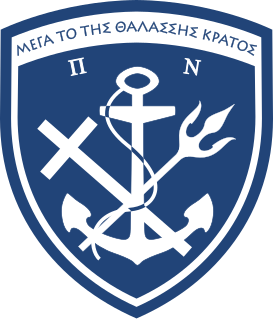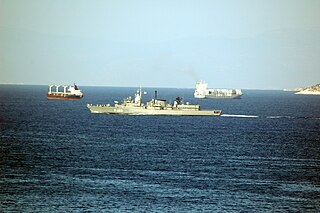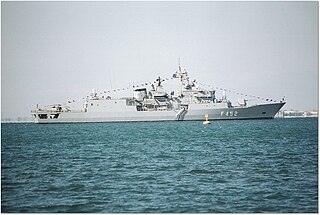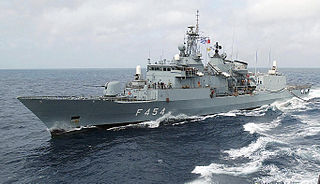This page is based on this
Wikipedia article Text is available under the
CC BY-SA 4.0 license; additional terms may apply.
Images, videos and audio are available under their respective licenses.

The Hellenic Navy is the naval force of Greece, part of the Hellenic Armed Forces. The modern Greek navy has its roots in the naval forces of various Aegean Islands, which fought in the Greek War of Independence. During the periods of monarchy it was known as the Royal Hellenic Navy.
Hydra generally refers to:
The History of the Hellenic Navy begins with the birth of modern Greece, and due to the maritime nature of the country, this force has been the premier service of the Greek Armed Forces.

The Elli-class frigates are a series of frigates operated by the Hellenic Navy. The ships are of Dutch origin and are also known as Kortenaer-class or Standard-class or S-class frigates. The first two ships, which have lengthened hangars and different armament were built specifically for the Hellenic Navy. The remaining ships are ex-Royal Netherlands Navy S-frigates of the Kortenaer class transferred to the Hellenic Navy in the late 1990s and early 2000s. Those ships constitute the backbone of the Greek Navy. Elli, for which the class is named, is itself named after two famous Greek cruisers, one of which was sunk during World War II.

Greek frigate Elli (F450) is the lead ship of the Greek Elli class of frigates and the third Hellenic Navy ship by that name. The class is based on the Royal Netherlands Navy's Kortenaer class and was built in a Dutch shipyard; however, unlike later members of its class in the Hellenic Navy, it was not originally in Dutch service, but was sold directly to Greece.

The Vasco da Gama class is a class of frigates of the Portuguese Navy. Named in honor of the Portuguese explorer Vasco da Gama, the ships are based on the German MEKO 200 design, and are Portugal's major surface ships. Portugal operates three ships of this class, which were built in Hamburg by Blohm + Voss (B&V) and by Howaldtswerke-Deutsche Werft (HDW) in Kiel, using modular construction techniques.
Hydra was a Greek destroyer of the Dardo class, which served with the Hellenic Navy during the early stages of the Second World War. It was named after the Saronic Gulf island of Hydra, which played an important role in the Greek War of Independence, and was the fourth ship to bear this name.

The Greek frigate Hellas was the flagship of the Revolutionary Hellenic Navy. After an arbitration hearing in New York due to financial default by the Greek government, she was delivered to Greece in 1826. She was burned in 1831 by the Greek Admiral Andreas Miaoulis when the government of Ioannis Kapodistrias ordered her turned over to the Russian navy.

The Salamis Naval Base is the largest naval base in Greece. It is located in the northeastern part of Salamis Island and in Amphiali and Skaramanga. It is close to the major population centre of Athens.

The Hydra class are a group of four frigates in service with the Hellenic Navy. They were designed in Germany and are part of the MEKO group of modular warships, in this case the MEKO 200 design. The programme was authorised in 1988 and partially paid for with FMS aid and previsioned for the commission of six vessels. The first ship was built in Germany and commissioned in 1992 but suffered a serious fire while working up near Portland, England. Repairs were completed in 1993. The Greek built warships were delayed due to financial problems on the part of the Hellenic Shipyards completing in the late 1990s which also led to limiting the total number of vessels to four mainly after the acquisition of eight Kortenaer class frigates from the Netherlands in the late 1990s.

Hydra (F-452) is the lead ship of the Greek Hydra-class frigate and flagship of the Hellenic Navy. The ship was built in the same shipyard as the Blohm + Voss MEKO 200 frigate class, on which its design was based. Three more vessels were built by Hellenic Shipyards Co. at Skaramagas in following years. It is the fifth ship in the Hellenic Navy to bear the name Hydra.

The Greek frigate Psara (F-454) is the third ship of the Greek Hydra-class frigates. It is based on the Blohm + Voss MEKO 200 frigate class and was built by Hellenic Shipyards Co. at Skaramangas as part of the programme.
She has participated in various NATO and international operations such as Sharp Guard, Decisive Enhancement, Operation Enduring Freedom, EU Operation Atalanta.

The Greek frigate Spetsai (F-453) is the second ship of the Greek Hydra frigate class. She is based on the Blohm + Voss MEKO 200 frigate class and was built by Hellenic Shipyards Co. at Skaramagas. She is the fifth ship of the Hellenic Navy to be named after the Saronic Gulf island of Spetses. She has participated in international operations such as Enduring Freedom.

The brig Aris, was one of the most distinguished Greek ships during the Greek War of Independence and continued to serve in the Greek Navy until the early 20th century as a training ship.
Five ships of the Hellenic Navy have borne the name Psara (Ψαρά), named after the island of Psara, which played a major role in the Greek War of Independence:
Five ships of the Hellenic Navy have borne the name Hydra or Ydra (Ύδρα), named after the island of Hydra, which played a major role in the Greek War of Independence:
At least three ships of the Hellenic Navy have borne the name Salamis, after the Greek island of Salamis and the Battle of Salamis:

Ouranos-class is a ship class of two coastal tankers used by the Hellenic Navy. The ships are almost identical in size. They were built in 1975-77 and they were commissioned into the Greek navy in 1977. Their main task is to supply other ships and naval bases of the Hellenic Navy with fuel and drinking water.














